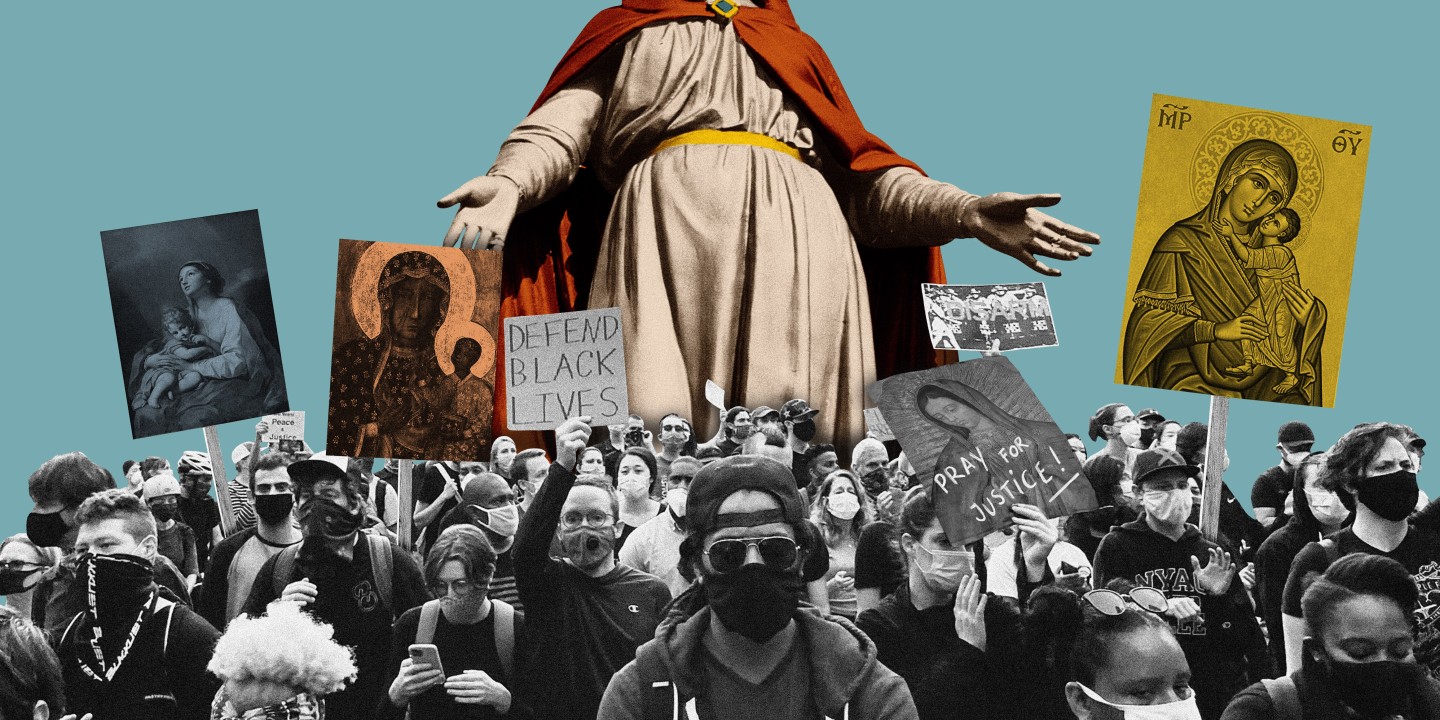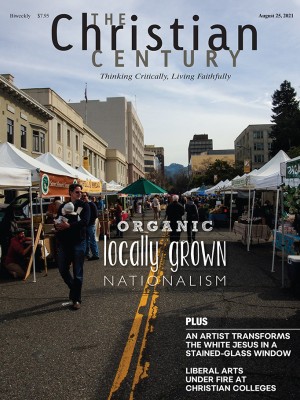Mary, mother of Jesus, returns as an icon for pop stars and activists

In recent months, rappers Lil Nas X, Bad Bunny, and Princess Nokia have all helped to spread a craze for Mary, mother of Jesus, by wearing designer Brenda Equihua’s splashy coats that commonly feature the Virgin of Guadalupe.
Of Mexican American heritage, Equihua equates the Virgin of Guadalupe with home. But there’s something deeper than simple nostalgia going on in her designs. “Wearing Mary in a fashion piece is unexpected,” she explained. “I think what’s cool is taking something out of context.”
Religious figures are often (if scandalously) appropriated outside sacred settings, but the decontextualization of Mother Mary has been in hyperdrive lately. She’s treated as a feminist beacon by people of all faiths and no faith alike, her likeness appearing alongside those of Frida Kahlo, Joan of Arc, and Ruth Bader Ginsburg.
Read our latest issue or browse back issues.
Mary lends cred to high-end guitar pedals created by female gear makers and pops up with increasing frequency on Etsy. Her story is being retold in provocative contemporary art and in the theses of up-and-coming scholars.
Ben Wildflower is a mail carrier by day and artist in his off hours. In 2016, he made a woodcut that shows Mary, her fist raised over her head, feet resting on a skull and a serpent (the former is a motif usually associated with Jesus’ disciple Mary Magdalene). In a circle around Wildflower’s image are the words “Fill the hungry. Cast down the mighty. Lift the lowly. Send the rich away.”
When he posted it on Instagram, it went viral.
Some critics called the woodcut’s message “un-Christian,” protesting that “God loves everyone.” The taunting language, however, is pulled directly from the Magnificat, the Gospel writer Luke’s version of a song attributed to Mary.
Wildflower, the child of evangelical Christian missionaries, now attends an Anglican church, is committed to living in solidarity with those living below the poverty line, and has been described as a “Christian anarchist.” He finds himself deeply drawn to the mother of Jesus and said he likes Mary’s vision of hierarchies being turned upside down.
Non-Christians, he said, are often interested in his work on Mary as a way of “seeking the divine feminine” via a sort of “DIY spirituality.” Further evidence of this approach can be found on sites such as Etsy, which sells Mother Mary oracle cards and altars for charging “reiki-energized” crystals that feature Mary’s likeness.
Catholic author and University of California, Berkeley, lecturer Kaya Oakes is not surprised by the new attention paid to Mary, noting that her appeal tends to grow when times are hard.
“Mary represents this side of God that is nurturing and will stay with you when you’re in pain,” Oakes said. “We’re coming out of this really traumatic phase in world history with the pandemic, and people have needed images of God that were more resonant with that compassionate, rather than judgmental, side of the divine.”
Mary traditionally shows up whenever she is most needed. For years, apparitions of the Virgin of Guadalupe have reportedly distracted border guards to help immigrants stranded at the US border slip into the country unnoticed.
Similarly, the culture tends to put Mary at the center of conflict. After Michael Brown was shot in Ferguson, Missouri, in 2014, Mark Doox’s icon Our Lady of Ferguson depicted her as a Black woman with her womb in the crosshairs of a gun and a child Christ in the center. Kehinde Wiley’s stained-glass image Mary, Comforter of the Afflicted casts the pietà as a Black man holding a dead child. Kelly Latimore’s Mama icon memorializes George Floyd by depicting Mary holding a broken Jesus.
Amey Victoria Adkins-Jones, who teaches theology at Boston College and focuses her scholarship on Mariology, said these artists are pulling from a long tradition of Black Madonnas.
“This imagery captures the legacy of grief that comes from injustice,” said Adkins-Jones. “Perhaps Mary is a ready figure to call to memory because Jesus is a person who dies unjustly at the hands of the state. . . . Questions of justice are always in conversation with artistic representations.”
For all of the seemingly renewed interest in Mary, Adkins-Jones notes that some of it isn’t so much new as a continuing tradition now aided by platforms such as Instagram that allow for fresh ways to “visually discuss.”
Still, according to Matthew Milliner, who teaches art history at Wheaton College, there is a kind of change afoot. When he started teaching classes on Mary shortly after his arrival at Wheaton in 2011, Milliner was surprised to see such consistent interest in the course from the largely Protestant student body.
The culture may soon move on from Mary, but Milliner believes Christians should keep her close, without fearing that love for the mother of God could threaten their love of Jesus.
“Love for Mary is a natural outgrowth of love for Christ,” he said. “They are not in competition, any more than love for my in-laws is in competition with love for my wife,” he said. “In short, meet the parents!” —Religion News Service






